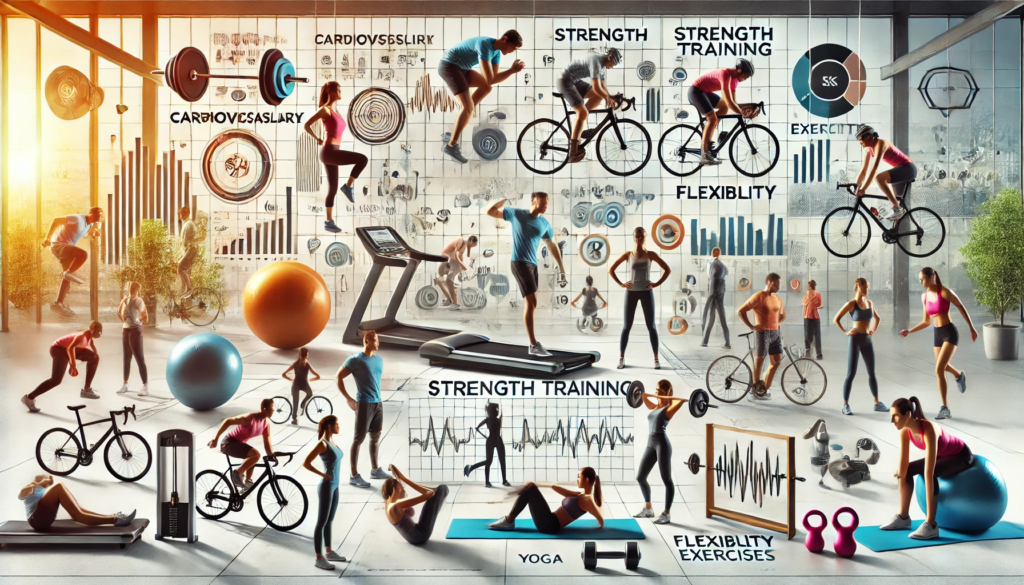Exercise is a crucial component of a healthy lifestyle, contributing to physical fitness, mental well-being, and overall health. There are various types of exercise, each with its unique benefits and focus areas. This guide provides an overview of the main types of exercise: cardiovascular, strength training, and flexibility exercises.
Cardiovascular Exercise
Cardiovascular exercise, also known as aerobic exercise, involves continuous, rhythmic activities that elevate the heart rate and improve the efficiency of the cardiovascular system. These exercises enhance endurance and overall heart health.
Examples of Cardiovascular Exercise
- Running: An excellent way to burn calories and improve cardiovascular fitness. It can be done outdoors or on a treadmill.
- Cycling: A low-impact activity that strengthens the heart and lungs. It can be done on a stationary bike or outdoors.
- Swimming: A full-body workout that is gentle on the joints while providing cardiovascular benefits.
- Walking: A simple and effective way to improve heart health, especially when done at a brisk pace.
- Rowing: Provides a full-body cardiovascular workout, engaging multiple muscle groups.
Benefits of Cardiovascular Exercise
- Improves Heart Health: Strengthens the heart and improves blood circulation.
- Enhances Endurance: Increases stamina and reduces fatigue.
- Burns Calories: Aids in weight management by burning calories.
- Reduces Stress: Releases endorphins that help reduce stress and improve mood.
Strength Training
Strength training, also known as resistance training or weight training, involves exercises that improve muscle strength and endurance. These exercises can be done using free weights, resistance bands, or body weight.
Examples of Strength Training Exercises
- Weightlifting: Using dumbbells, barbells, or weight machines to target specific muscle groups.
- Bodyweight Exercises: Push-ups, pull-ups, squats, and lunges that use body weight for resistance.
- Resistance Bands: Exercises using elastic bands to provide resistance and improve muscle tone.
- Kettlebell Workouts: Dynamic exercises that combine strength and cardio using kettlebells.
- Circuit Training: A series of strength exercises performed one after the other with minimal rest.
Benefits of Strength Training
- Increases Muscle Mass: Builds and maintains muscle mass, which is essential for overall strength and metabolism.
- Enhances Bone Health: Increases bone density and reduces the risk of osteoporosis.
- Boosts Metabolism: Increases metabolic rate, helping with weight management.
- Improves Functional Fitness: Enhances the ability to perform daily activities with ease.
Flexibility Exercise
Flexibility exercises focus on improving the range of motion of muscles and joints. These exercises help reduce muscle tension, improve posture, and prevent injuries.
Examples of Flexibility Exercises
- Yoga: Combines physical postures, breathing exercises, and meditation to improve flexibility and overall well-being.
- Stretching: Involves various techniques to lengthen muscles and improve joint flexibility.
- Pilates: Focuses on core strength, flexibility, and overall body conditioning.
- Tai Chi: A gentle form of exercise that incorporates slow, controlled movements to improve balance and flexibility.
- Dynamic Stretching: Involves active movements that stretch muscles through their full range of motion, often used as a warm-up.
Benefits of Flexibility Exercise
- Improves Range of Motion: Enhances the flexibility of muscles and joints, allowing for greater movement and reduced stiffness.
- Reduces Risk of Injury: Helps prevent injuries by preparing muscles and joints for activity.
- Enhances Posture: Improves posture and alignment, reducing the risk of back pain and other musculoskeletal issues.
- Relieves Stress: Promotes relaxation and reduces muscle tension.
Conclusion
Incorporating a variety of exercise types into your fitness routine can provide comprehensive health benefits, including improved cardiovascular health, increased muscle strength, and enhanced flexibility. Whether you prefer running, weightlifting, or yoga, each type of exercise contributes to overall fitness and well-being. A balanced exercise routine that includes cardiovascular, strength, and flexibility exercises can help you achieve your fitness goals and maintain a healthy lifestyle.
Frequently Asked Questions
How often should I do cardiovascular exercise?
The American Heart Association recommends at least 150 minutes of moderate-intensity or 75 minutes of high-intensity cardiovascular exercise per week. This can be spread out over several days.
Can strength training be done without weights?
Yes, strength training can be done using body weight, resistance bands, or other equipment like kettlebells and medicine balls. Bodyweight exercises such as push-ups, squats, and lunges are effective for building strength.
Is it necessary to stretch every day?
While it’s not mandatory to stretch every day, incorporating flexibility exercises into your routine a few times a week can significantly improve your range of motion and prevent injuries. Daily stretching can be beneficial, especially if you have a sedentary lifestyle.
Can I combine different types of exercise in one workout?
Yes, combining different types of exercise in one workout can provide a well-rounded fitness routine. For example, you can start with cardiovascular exercise, follow with strength training, and finish with flexibility exercises.
How can I prevent injuries while exercising?
To prevent injuries, it’s essential to warm up before exercising, use proper form and technique, avoid overtraining, and listen to your body. Incorporating rest days and varying your workout routine can also help reduce the risk of injury.
What are the benefits of combining cardiovascular and strength training exercises?
Combining cardiovascular and strength training exercises can improve overall fitness, enhance endurance, build muscle mass, and boost metabolism. This combination can also lead to better weight management and a reduced risk of chronic diseases.


